Asset recovery statistical bulletin: financial years ending 2016 to 2021
Published 9 September 2021
Applies to England, Northern Ireland and Wales
The Proceeds of Crime Act 2002
The Proceeds of Crime Act (POCA) 2002 outlines the statutory framework used to enable the investigation and prosecution of crimes relating to benefit from criminal conduct; or crimes relating to property obtained through unlawful conduct or which is intended to be used in unlawful conduct. It is also used to deprive criminals of their money or other property connected to criminal activity. POCA can be applied through the following powers: Criminal Confiscation, Forfeiture, Civil Recovery and Taxation. Links to further information on POCA can be found in the Background Context Note.
About this Release
This release contains Official Statistics on the value and volume of proceeds of crime restrained, seized, and recovered through Criminal Confiscations, Forfeitures and Civil Recovery. It also includes statistics on the value of compensation paid to victims, the use of funds by POCA agencies received through the Asset Recovery Incentivisation Scheme (ARIS) and statistics on International Asset Recovery. Links to statistics published by HM Revenue and Customs (HMRC) on the collection of Civil Recovery and Taxation can be found in the Methodology and Quality Report.
This release refers to data covering the financial years from 2015 to 2016 until 2020 to 2021, which is the latest period, and is provided for the jurisdictions of England and Wales, Northern Ireland and those which have no recorded jurisdiction. This release does not include data covering Scotland.
This release includes data covering the period 1 April 2020 to 31 March 2021 which is the same period as when COVID-19 restrictions were in place. COVID restrictions had an impact across the entire law enforcement, criminal justice, and asset recovery systems, adversely impacting on investigation, prosecution and conviction capacity and capability.
It should be noted there will be variations in the data recorded for each financial year due to revisions made in retrospection of the live administrative JARD system. Figures included in the latest statistical release supersede previous officially reported figures. Therefore, any direct comparisons of changes in asset recovery performance should not be made between the latest and previous releases of the Asset Recovery Annual Statistical Bulletin. Statistical information on this is outlined in the Methodology and Quality Report.
There is additional legislation to POCA which can be used for the detaining and seizure of criminal assets such as the Misuse of Drugs Act 1971 and the Modern Slavery Act 2015. It should be noted that this release does include cases under these Acts.
Data presented on Unexplained Wealth Orders (UWOs) was provided by the National Economic Crime Centre (NECC) in May 2021 for the financial year ending March 2021.
Main Additions and Changes to the Bulletin
There have been some changes in the methodology for this statistical release which concern the values and volumes of proceeds of crime. It means there will be differences in figures reported in this release to those previously released. Further details of these changes can be found in the Methodology and Quality Report.
Experimental statistics on Civil Recovery Order receipts covering the financial years from 2016 to 2017 until 2020 to 2021 have also been included in this release for the first time. There has also been the inclusion of Experimental Statistics on the proceeds of crime recovered through International Asset Recovery.
Further information on Experimental Statistics can be found in the Methodology and Quality Report.
Main Headlines
Figure 1: The value of proceeds of crime recovered from Confiscation Orders, Forfeiture Orders and Civil Recovery Orders receipts from financial year 2015 to 2016 until financial year 2020 to 2021 in England and Wales, Northern Ireland jurisdictions and those which have no recorded jurisdiction

Source: JARD (Confiscation Order and Forfeiture Order receipts) and NCA (Civil Recovery Order receipts)
Notes
- Data for Civil Recovery Order receipts was not provided prior to the financial year 2016 to 2017 due to the lack of data being available on the NCA’s administrative database.
-
£219 million was recovered in the total proceeds of crime from Confiscation Orders, Forfeiture Orders and Civil Recovery Orders receipts in the financial year 2020 to 2021; an increase of 4% from the financial year 2016 to 2017, due to the increase in the proceeds of crime recovered from Forfeiture Order receipts and the inclusion of the proceeds of crime recovered from Civil Recovery Order receipts
-
£99 million was recovered through Confiscation Orders receipts in the financial year 2020 to 2021, the lowest amount recovered in the last six years
-
Forfeiture Order receipts reached a 6 year peak with £107 million being recovered in the financial year 2020 to 2021, which is due to the inclusion of Account Freezing Orders and Listed Asset Orders introduced under the Criminal Finances Act 2017 and large scale operations that have driven up the proceeds of crime seized under Cash Seizures
-
£13 million was recovered through Civil Recovery Orders receipts in the financial year 2020 to 2021, which is the highest amount recovered in the last five years
-
£17 million was paid in compensation to victims from the recovery of criminal proceeds through Confiscation Orders receipts in the financial year 2020 to 2021, a decrease of 57% from the financial year 2015 to 2016 which can be partially explained by the decline in the volume of Confiscation Order Impositions and subsequent receipts which have fallen in the same period
Background Information
These statistics are released every year and are produced using data collected on a live operational database, the Joint Asset Recovery Database (JARD). This means data is subject to change as cases are resolved, varied, appealed and new cases are added.
The data presented for Forfeitures includes the amount of assets seized and recovered by way of Cash Seizures, Account Freezing Orders (Bank Accounts) and Listed Asset Orders. The latter two powers were introduced under the Criminal Finances Act 2017 (CFA) and came into force from 31 January 2018 together with UWOs. The Account Freezing Orders, Listed Asset Orders and UWOs are available to use in England and Wales, Northern Ireland, and Scotland, however the statistics in this release are only reported for England and Wales. It is important to note that data presented in this release for Account Freezing Orders and Listed Asset Orders does not cover Northern Ireland, as these powers were not in force in this jurisdiction for the reported period in this release for the financial years ending 2016 and 2021.
Data presented on the proceeds of crime recovered for cases where the main offence is Modern Slavery is extracted from JARD and presented in Annex A. It has been provided to support the Modern Slavery Annual Report released in October 2020.
Data presented on Civil Recovery Orders receipts is provided by the National Crime Agency (NCA).
Data presented on the Use of ARIS Funds is taken from a survey managed by Home Office.
Data presented on International Cooperation and Asset Return cases is in Annex B and is provided by a Home Office administrative database.
Further information on data sources, data and statistics quality, methodology and adherence to the Code of Practice for Statistics can be found in the accompanying Methodology and Quality Report.
Information on the definitions for different civil and criminal powers can be found in the accompanying Background Context Note.
The Proceeds of Crime Restrained and Recovered through Criminal Confiscation Powers
The asset recovery powers in POCA to deprive and recover the proceeds of crime or other property connected to criminal activity can be applied through criminal confiscation.
Part 2 of POCA makes provision for the confiscation of a person’s benefit from criminal conduct, following a criminal conviction. If the relevant statutory conditions are satisfied, the court must decide the recoverable amount for that person and make an order (a Confiscation Order) requiring him to pay that amount.
This section provides a summary of the statistics on the value and volume of the proceeds of crime restrained, and recovered under the POCA powers through criminal confiscation as follows:
- Restraint Orders
- Confiscation Order Impositions
- Confiscation Order Receipts
Further information on the legislative background and the criminal confiscation system process for proceeds of crime under POCA, including Restraint Orders, Confiscation Order Impositions and Confiscation Order receipts, can be found in the Background Context Note.
Restraint Orders
Figure 2: Restraint Orders – values and volumes, from financial year 2015 to 2016 until financial year 2020 to 2021, in England and Wales, Northern Ireland and those which have no recorded jurisdiction

Source: JARD
Notes
-
Data presented in Figure 2 includes proceeds of crime that are restrained and cannot be accessed by the defendant whilst confiscation proceedings and enforcement are ongoing. It does not reflect the proceeds of crime recovered at the end of the criminal proceedings.
-
This does not reflect the proceeds of crime recovered at the end of the criminal proceedings due to legislation which enables Confiscation Orders to be imposed without having a previous Restraint Order. There is therefore no direct comparison between the value of subject to a Restraint Order and the amounts successfully recovered as Confiscation Order receipts. Users should be cautious when making comparisons between the data reported for Restraint Orders and Confiscation Orders Impositions for this reason.
The value of proceeds of crime restrained through Restraint Orders peaked at £1.8bn in financial year 2018 to 2019, and then fell by 65% to £614m in financial year 2020 to 2021 - a fall of 57% when compared to financial year 2015 to 2016.
The volume of Restraint Orders has seen an overall decline over the previous six financial years, decreasing from 1,300 in financial year 2015 to 2016 to 1,200 in financial year 2020 to 2021.
Confiscation Order Impositions
Figure 3: Confiscation Order Impositions – values and volumes from financial year 2015 to 2016 until financial year 2020 to 2021, in England and Wales, Northern Ireland and those which have no recorded jurisdiction
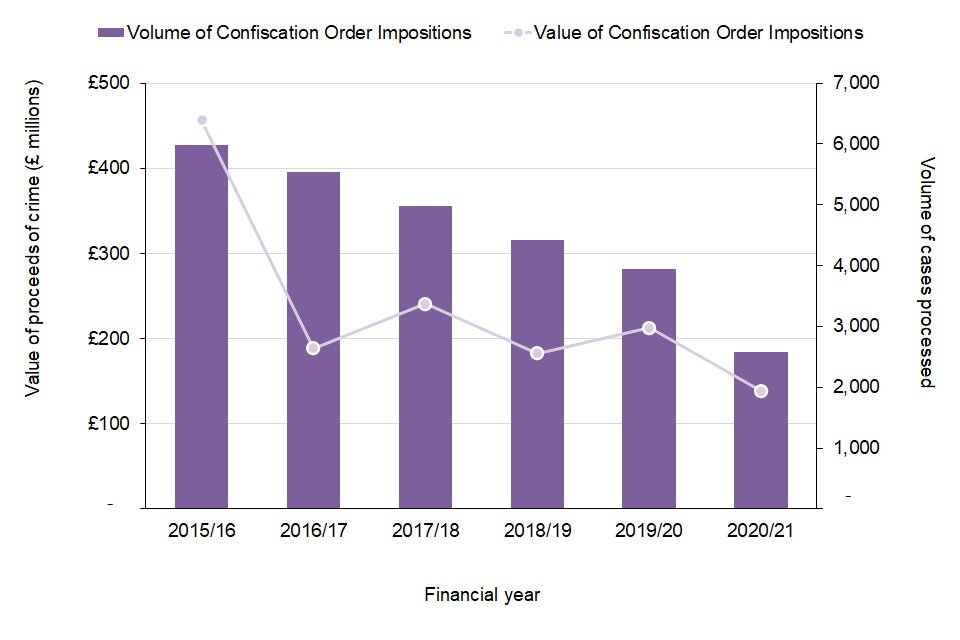
Source: JARD
Notes
1.Data presented in Figure 3 includes proceeds of crime which the defendant is ordered to pay back and are the benefits of criminal activity. These proceeds are deemed recoverable from the defendant following the granting of a Confiscation Order by the court. It does not reflect the proceeds of crime which are subsequently recovered through enforcement action and payments.
The value of Confiscation Order Impositions has been on an overall downward trend since peaking at £457m in financial year 2015 to 2016 and is currently at its lowest level of £139m, a decline of 70%.
The volume of Confiscation Order Impositions has seen an overall decline over the previous six financial years and is currently at its lowest level. In the financial year 2020 to 2021, the volume of Confiscation Order Impositions was 2,600, a decrease of 57% when compared to the peak in the financial year 2015 to 2016 from 6,000.
Confiscation Order Receipts
Figure 4: Confiscation Orders receipts – values and volumes from financial year 2015 to 2016 until financial year 2020 to 2021, in England and Wales, Northern Ireland and those which have no recorded jurisdiction

Source: JARD
Notes
- Figure 4 shows the value of proceeds of crime recovered (paid against Confiscation Order Impositions) from the defendant following the end of criminal proceedings. It includes payments received from the defendant in each financial year on any outstanding Confiscation Orders they must pay back based on their available funds. Users should take caution when making comparisons between the data presented for Confiscation Order Impositions and Confiscation Order receipts for this reason.
In the financial year 2015 to 2016 the value of proceeds of crime recovered reached a peak of £207m, which was driven by several large Confiscation Orders Impositions being paid.
Since then, the value of proceeds of crime recovered through Confiscation Order receipts has fallen to £99m in the financial year 2020 to 2021.
The longer-term downward trend in Confiscation Order receipts reflects a wider shift to the use of civil powers under POCA from criminal powers and is set out in Guidance note on POCA, Section 2a . It outlines the reduction of crime can be better secured through criminal proceedings where a defendant is required to pay back any proceeds of crime from available assets but also highlights the importance of civil powers in reducing crime. These powers can be applied if the relevant authority deems them to be the most effective for reducing crime.
In addition, in the financial year 2020 to 2021 the introduction of COVID-19 restrictions has impacted across the entire asset recovery systems which resulted in impacts on the investigation, prosecution and conviction capacity and capability. This in turn could have impacted Confiscation Order Imposition cases.
A similar decline is observed in the number of cases of Confiscation Order receipts processed, which fell by 57% from 6,000 cases in the financial year 2015 to 2016 to 2,600 cases in the financial year 2020 to 2021.
This persistent downward trend has resulted in lower proceeds of crime recovered through Confiscation Order receipts.
The Proceeds of Crime Seized, Frozen and Recovered through Civil Powers
Forfeiture Powers
The asset recovery powers in POCA to deprive and recover the proceeds of crime or other property connected to criminal activity can be applied through Forfeiture powers.
Forfeiture powers enable the seizure, detention and forfeiture of cash, monies in relevant accounts or listed assets, which is determined to be or to represent property obtained through unlawful conduct or property intended for use by any person in unlawful conduct.
This section provides a summary of the statistics on the value and volume of the proceeds of crime seized and frozen (detained) and recovered (forfeited) under the POCA powers for Forfeitures as follows:
- The value and volume of proceeds of crime seized and frozen (detained) through all Seizure sub-type Forfeiture powers;
- The value and volume of proceeds of crime recovered from Forfeiture Order receipts and through all Seizure sub-type Forfeiture Order powers;
There has been a change in the methodology used in this statistical release for the value of proceeds of crime recovered through Forfeiture Order receipts. Further details of this change are written in the Methodology and Quality Report in the Main Methodology Changes section, which also explains why comparisons between this release and previous releases should be avoided.
Further information on the legislative background and the civil system process for proceeds of crime under POCA, including Forfeiture sub-type powers and Forfeiture Order receipts can be found in the Background Context Note.
Proceeds of Crime Seized, Frozen (detained) and Recovered through Forfeitures
The Value of Proceeds of Crime Seized through All Seizure Sub-types
Figure 5: The value of proceeds of crime seized under All Seizure Sub-types from financial year 2015 to 2016 until financial year 2020 to 2021, in England and Wales, Northern Ireland and those which have no recorded jurisdiction
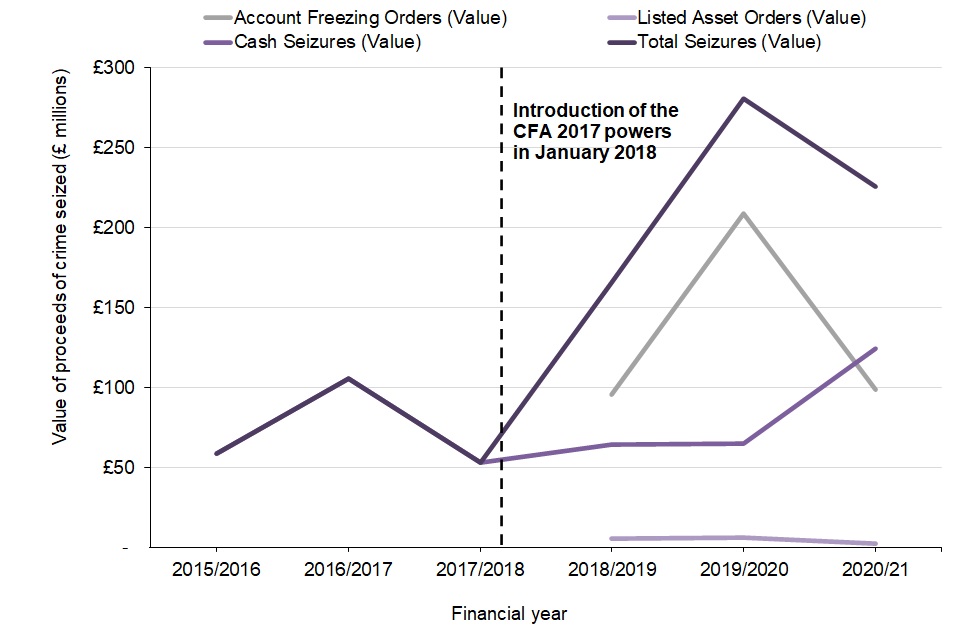
Source: JARD
Notes
-
Data presented in Figure 5 shows the value of assets or proceeds of crime seized that cannot be accessed by the respondent whilst the investigation is undertaken (subject to exclusions, for example, to carry on any trade, business, profession or occupation). It does not reflect the proceeds of crime which are recovered at the end of the investigation from the respondent.
-
Data presented for Account Freezing Orders and Listed Asset Orders does not cover Northern Ireland, as these powers were not in force in this jurisdiction for the reported period.
-
These powers can only be used where assets or proceeds of crime are worth more than the prescribed minimum amount currently set at £1,000. The data set is reflective of this.
The total value of proceeds of crime seized reached a 6-year peak of £281m in financial year 2019 to 2020. This increase appears to be driven by a rise in the value of proceeds of crime seized under Cash Seizures and the introduction of additional seizure powers in the CFA 2017, in particular Account Freezing Orders and Listed Asset Orders.
In the financial year 2020 to 2021 the total value of proceeds of crime seized was £226m, representing a decrease of 20% from £281m from the financial year 2019 to 2020. The rise in the value of proceeds of crime seized under Cash Seizures can be attributed to a large-scale operation that ended in the financial year 2020 to 2021, where a large amount of proceeds of crime were seized under Cash Seizures.
Account Freezing Orders and Listed Asset Orders
Since their introduction, the proceeds of crime seized under Account Freezing Orders have marginally increased by 4%, reaching £99m in financial year 2020 to 2021 and peaking at £209m in financial year 2019 to 2020. This peak in the financial year ending 2020 is driven by an operation involving several high value cases where proceeds of crime were seized under Account Freezing Orders.
The proceeds of crime seized under Listed Assets was £2.6m, a fall of 61% compared to financial year 2019 to 2020, and a fall of 56% compared to financial year 2018 to 2019 from £5.7m.
In the financial year 2020 to 2021, Cash Seizures have continued to account for a larger proportion of total seizures (55%) due to their greater use to seize the proceeds of crime in large scale operations, compared to Account Freezing Orders (44%) and Listed Asset Orders (1%).
Figure 6: The volume of proceeds of crime seized under All Seizure Sub-types from the financial year 2015 to 2016 until financial year 2020 to 2021, in England and Wales, Northern Ireland and those which have no recorded jurisdiction

Source: JARD
Notes
-
These powers can only be used where assets or proceeds of crime are worth more than the prescribed minimum amount currently set at £1,000. The data set is reflective of this.
-
Data presented for Account Freezing Orders and Listed Asset Orders does not cover Northern Ireland, as these powers were not in force in this jurisdiction for the reported period.
The number of total seizures processed reached a 6-year high of 4,700 in financial year 2020 to 2021 and has risen by 8% when compared to the financial year 2015 to 2016.
Overall, the increase in the total volume of proceeds of crime seized from total seizures in the financial year 2020 to 2021 was largely driven by the increasing volumes seized through Account Freezing Orders and Listed Asset Orders.
Since their introduction in the financial year 2018 to 2019, the volumes seized through Account Freezing Orders and Listed Asset Orders has increased by 51% (from 630 to 950) and 89% (from 60 to 120) in the financial year 2020 to 2021.
However, Cash Seizures have continued to account for a larger proportion of the total volume of proceeds of crime seized. This in part can be attributed to a large-scale operation which ended this financial year, involving high value cases processed through Cash Seizures to seize the proceeds of crime.
Forfeiture Order Receipts
Figure 7: The value of proceeds of crime recovered through Forfeiture Order receipts from the financial year 2015 to 2016 until financial year 2020 to 2021, in England and Wales, Northern Ireland and those which have no recorded jurisdiction
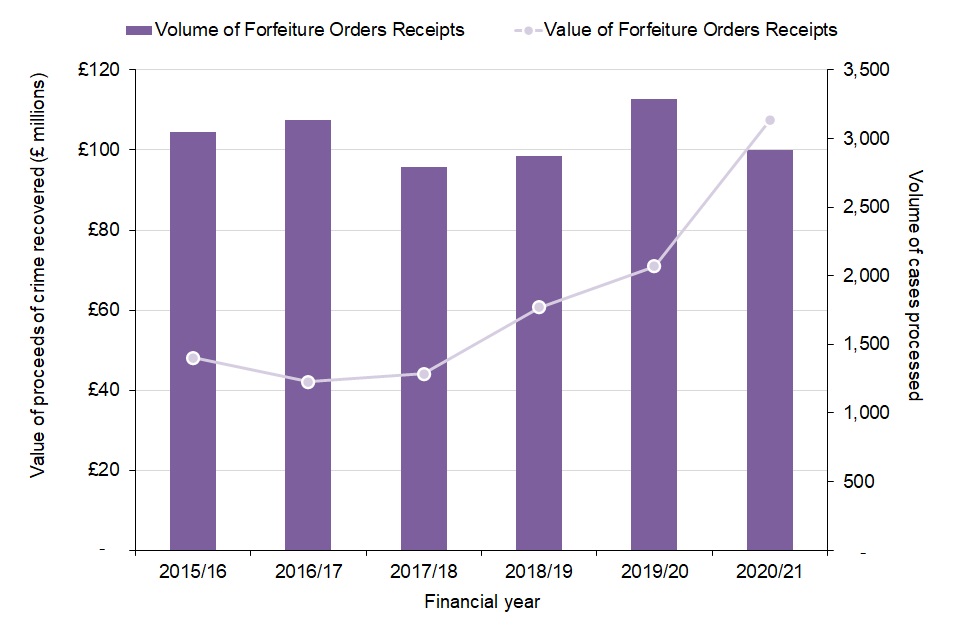
Source: JARD
Notes
-
Data presented Figure 8 shows the proceeds of crime recovered at the end of an investigation from the respondent. It includes proceeds of crime recovered on an outstanding Forfeiture Order in a given financial year once the order is imposed. This means proceeds recovered could be linked to a seizure from a previous financial year.
-
These powers can only be used where assets or proceeds of crime are worth more than the prescribed minimum amount currently set at £1,000. The data set is reflective of this.
Forfeiture Order receipts have been on an increasing trend since the financial year 2015 to 2016. In financial year 2020 to 2021, the amount recovered reached a six year high at £107m, an increase of 52% compared to the previous financial year (from £70.9m), and an increase of 123% (from £48.1m) compared to financial year 2015 to 2016.
The increase in Forfeiture Order receipts from the financial year 2019 to 2020, by 52% (from £70.9m) has in part been driven by several factors, including the increased use of Forfeiture Order sub-type powers under the civil system with operations involving the use of civil powers like Cash Seizures to recover the proceeds of crime.
Moreover, COVID-19 restrictions have impacted across the entire asset recovery systems which resulted in impacts on the investigation, prosecution and conviction capacity and capability. This could have led to an increase in the use of civil powers such as Forfeiture Orders in the recovery of the proceeds of crime.
The definition for Forfeiture Order sub-types can be found in the Background and Context Note in the ‘Definitions of POCA Powers’ section.
Account Freezing Orders and Listed Asset Orders
The proceeds of crime recovered through Account Freezing Orders has steadily increased since financial year 2018 to 2019 from £6.0m to £32.2m in the financial year 2020 to 2021. In the financial year 2020 to 2021, there was an increase of 141% in the proceeds of crime recovered from the previous financial year. This is due to the recovery of proceeds of crime from several high value cases using this Forfeiture Order sub-type power in the financial year 2020 to 2021.
A similar trend is present in the proceeds of crime recovered using Listed Asset Orders which rose from £0.3m in financial year 2018 to 2019 to £1.6m in financial year 2020 to 2021. This shows a rise in the proceeds of crime recovered for this Forfeiture Order sub-type power by 154%.
In the financial year 2020 to 2021 by Forfeiture Order sub-type, Cash Seizures have continued to account for a larger proportion of total Forfeiture Order receipts (68%), compared to Account Freezing Orders (30%) and Listed Asset Orders (2%).
A different pattern is observed in the volume of Forfeiture Order receipts processed which fell slightly to 3,000 cases in the financial year 2020 to 2021, a 4% decrease from financial year 2015 to 2016, and a 12% decrease when compared to financial year 2019 to 2020. This decline in the number of cases processed are driven by a fall in the cases processed under Cash Seizures.
Civil Recovery Investigative Tools
A UWO is an investigate tool which can be granted to specific law enforcement agencies in respect of individuals or companies suspected of being involved in or having links with serious crime or against Politically Exposed Persons (PEPs) from outside the European Economic Area. An Interim Freezing Order can also be applied for alongside a UWO to prevent property being dissipated during the proceedings.
Further information on the legislative background and the civil system process for proceeds of crime under POCA, including UWOs, can be found in the Background Context Note.
At the financial year ending March 2021, the NCA had obtained UWOs in 4 cases since their introduction in 2018 with an estimated total value of £143m.
There have not been any UWOs obtained since July 2019.
Civil Recovery Powers
The asset recovery powers in POCA to deprive and recover the proceeds of crime or other property connected to criminal activity can be applied through civil recovery.
Civil Recovery Order powers enable an enforcement authority to recover property which is determined to be or to represent property obtained through unlawful conduct. Applications are made in civil proceedings before the High Court. This section provides a summary of the statistics on the value of the proceeds of crime recovered under the POCA powers for Civil Recovery Order receipts.
Further information on the legislative background and the civil system process for proceeds of crime under POCA, including Civil Recovery Order receipts, can be found in the Background Context Note.
Civil Recovery Order Receipts
These statistics are badged as experimental due to the quality of the administrative dataset which has been used in their production. It should be noted this is the first time statistics on Civil Recovery Order receipts have been included in this statistical release. Data was not provided prior to the financial year 2016 to 2017 due to the lack of data being available on the administrative database. For further information on Experimental Statistics please refer to the accompanying Methodology and Quality Report.
Figure 8: The value of proceeds of crime recovered through Civil Recovery Order receipts from the financial year 2016 to 2017 until financial year 2020 to 2021, in England and Wales, Northern Ireland and those which have no recorded jurisdiction

Source: NCA
Notes
-
Data presented in Figure 9 shows the proceeds of crime recovered at the end of the investigation from a respondent. It includes proceeds recovered on a Civil Recovery Order within a given financial year once the order is imposed. This means the proceeds of crime recovered from Civil Recovery Order receipts could be linked to an order in a previous financial year.
-
Data was not provided prior to the financial year 2016 to 2017 due to the lack of data being available on the administrative database.
Civil Recovery Order receipts have generally been increasing since the financial year 2016 to 2017. The value of proceeds of crime recovered from Civil Recovery orders was £12.7m in the financial year 2020 to 2021, an increase of 42% from £8.9m in the previous year and an increase of 77% from £7.2m in the financial year 2016 to 2017.
Use of Asset Recovery Incentivisation Scheme (ARIS) Funds
Figure 9: Use of ARIS funds by POCA agencies on Asset Recovery work provided by survey returns from the financial year 2015 to 2016 until financial year 2019 to 2020, in England and Wales and Northern Ireland
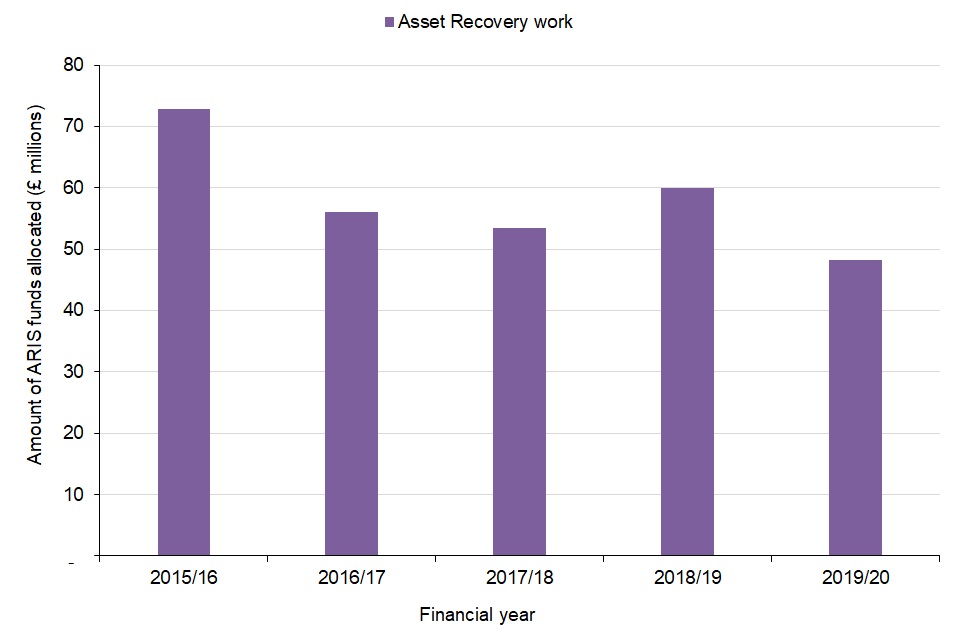
Source: Home Office
Notes
- Data presented in Figure 9 shows the use of ARIS funds based on survey returns submitted by POCA partners to the Home Office. It does not provide figures on the total ARIS funds available within each financial year which are based on the total proceeds of crime recovered. These funds are divided between the Home Office and its operational partners, with allocations to partners based on their relative contribution.
Response rates for the Use of ARIS funds survey in financial years 2017 to 2018 and 2018 to 2019 were 43%, with 111 law enforcement agencies out of 260 providing a response. This rate dropped slightly in the financial year 2019 to 2020 to 36%, with 93 responses received from law enforcement agencies.
The survey returns submitted by POCA agencies shows that the allocation of ARIS funds used by POCA agencies to fund future asset recovery work related projects has declined by 34%, from £72.9m in financial year 2015 to 2016 to £48.3m in the financial year 2019 to 2020.
In the financial year 2019 to 2020 the survey results, based on 68 of the 93 law enforcement agencies who responded, also reveal that 72% of the total ARIS funds available to POCA agencies was allocated to future asset recovery work projects, a decline of 10 percentage points from the financial year 2018 to 2019. The response rate to this question in the survey has been broadly similar for the past two previous financial years, with 76% (84 law enforcement agencies) and 79% (88 law enforcement agencies) responding in the financial years 2018 to 2019 and 2017 to 2018 respectively.
Figure 10: Use of ARIS funds by POCA agencies on Crime reduction projects, Community projects and Miscellaneous projects provided by survey returns from the financial year 2015 to 2016 until financial year 2019 to 2020, in England and Wales and Northern Ireland
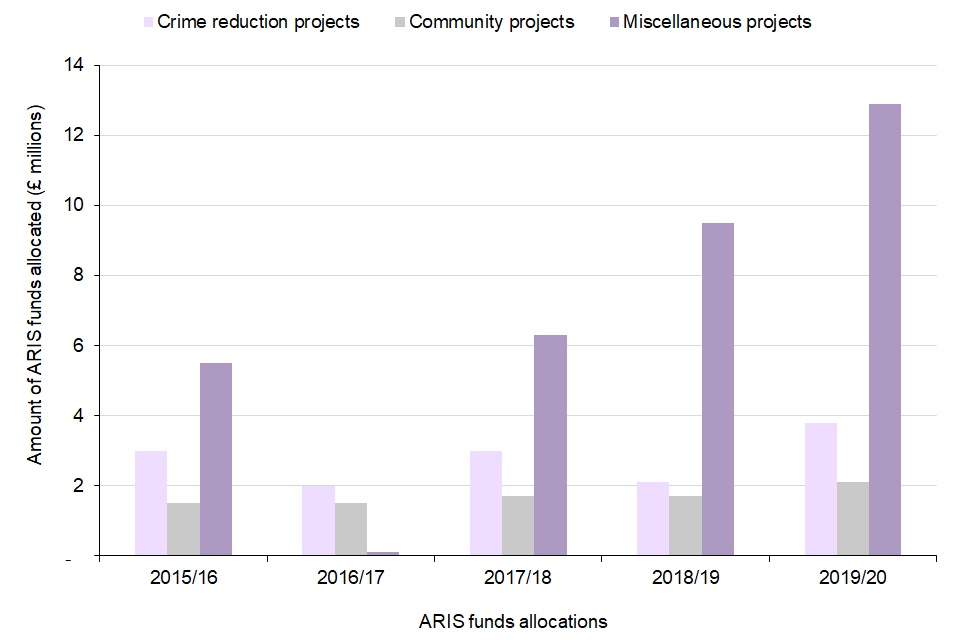
Source: Home Office
Notes
-
The Miscellaneous category refers to any funds received from ARIS that have been allocated for purposes which fall outside of the other three categories presented.
-
Data presented in Figure 10 shows the allocation of funds based on returns submitted by POCA partners to the Home Office. It does not provide allocations based on the total ARIS funds available within each financial year.
The survey returns submitted by POCA agencies reveal that the allocation of ARIS funds used for crime reduction projects, has risen by 27% from £3m in the financial year 2015 to 2016 to £3.8m in the financial year 2019 to 2020.
In the financial year 2019 to 2020 the survey results, based on 33 out of 93 law enforcement agencies who have responded, reveal that 6% of the total ARIS funds available to POCA agencies was allocated to crime reduction projects, an increase of 3 percentage points from the financial year 2018 to 2019. The response rate to this question in the survey has been broadly similar for the past two previous financial years, with 34% (38 law enforcement agencies) and 41% (46 law enforcement agencies) responding in the financial years 2018 to 2019 and 2017 to 2018 respectively.
Compensation to Victims
Figure 11: Total compensation paid to victims from the financial year 2015 to 2016 until the financial year 2020 to 2021, in England and Wales, Northern Ireland and those which have no recorded jurisdiction
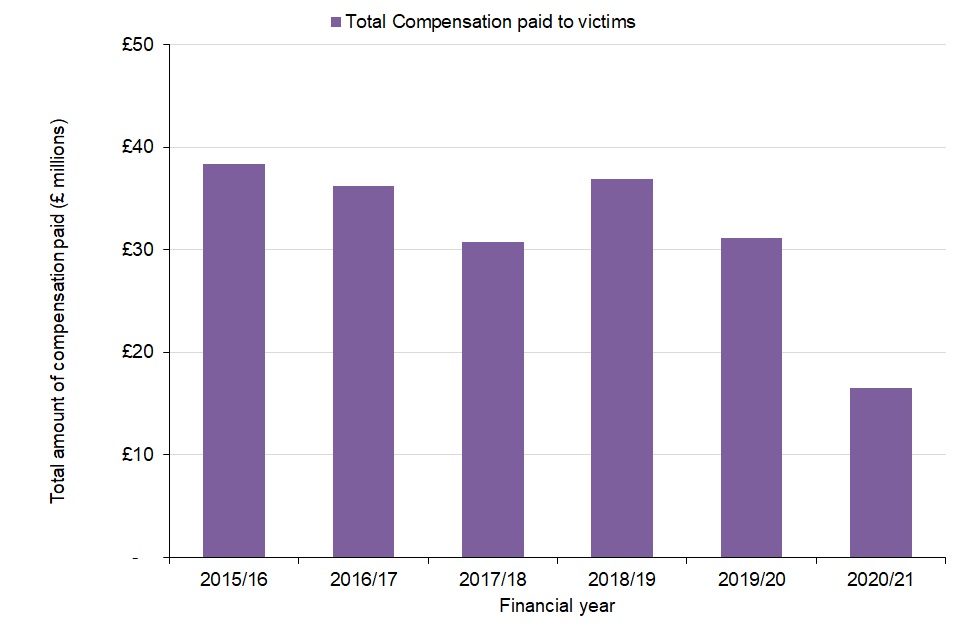
Source: JARD
Notes
-
A court imposing a Confiscation Order can also order an offender to pay compensation to the victim of their crime. If the offender does not have the means to satisfy both a Confiscation Order and Compensation Order, the court can order that Compensation Order to be payable from the sums recovered as part of the Confiscation Order.
-
Data in Figure 12 captures the total amount paid out to all victims as compensation (from confiscation) from the financial year 2015 to 2016 to the financial year 2020 to 2021.
There is a decline in the total amount of compensation paid to victims with £16.5m paid in the financial year 2020 to 2021, a 57% decrease from £38.4m in the financial year 2015 to 2016. The total compensation paid to victims peaked in the financial year 2015 to 2016 and has remained below this level in subsequent financial years.
The financial year 2020 to 2021 is the only financial year where there has been a substantially large decline in the total compensation paid out. It can be partially explained by the decline in the volume of Confiscation Order Impositions and subsequent receipts which have fallen in the same period. Generally, in the previous five financial years, the total compensation paid to victims has been between £30 to £40 million.
Annexes
Annex A: Modern Slavery Data
Modern slavery data is published as a distinct subset of data, as it is the only data reported by offence type.
Figure 12: The value of proceeds of crime restrained and recovered through Restraint Orders, Confiscation Orders and Forfeitures receipts where the offence is Modern Slavery from the financial year 2015 to 2016 until financial year 2020 to 2021, in England and Wales, Northern Ireland and those which have no recorded jurisdiction

Source: JARD
Between the financial years 2015 to 2016 and 2020 to 2021 the value of proceeds recovered from Confiscation Orders and Forfeiture Orders for modern slavery offences followed a generally positive trend.
In the financial year 2017 to 2018, the value of proceeds of crime restrained through Restraint Orders reached a peak of £6.5m and has seen a downward trend since. The value of proceeds of crime from Restraint Orders is currently at its lowest level for the last six years.
More specifically:
- £0.9m was recovered from Confiscation Orders receipts in the financial year 2020 to 2021, a 117% increase from £0.4m in the financial year 2015 to 2016
- £0.2m was recovered from Forfeiture Orders receipts in the financial year 2020 to 2021, which represents no change since the financial year 2015 to 2016
- £0.5m was restrained from Restraint Orders in the financial year 2020 to 2021, a 71% decrease from £1.8m in the financial year 2015 to 2016
Figure 13: The volume of proceeds of crime restrained and recovered through Restraint Orders, Confiscation Orders and Forfeiture Orders receipts where the offence is Modern Slavery from the financial year 2015 to 2016 until financial year 2020 to 2021, in England and Wales, Northern Ireland and those which have no recorded jurisdiction

Source: JARD
The volume of cases processed under of the respective powers have gradually increased over the last six financial years from the financial year 2015 to 2016 to the financial year 2020 to 2021 except for Forfeiture Orders receipts:
- 10 Restraint Orders were processed in the financial year 2020 to 2021, and have remained the same since the financial year 2015 to 2016
- 320 Confiscation Orders were processed in the financial year 2020 to 2021
- 10 Forfeiture Orders were processed in the financial year 2020 to 2021
Annex B: International Asset Recovery
These statistics are badged as experimental due to the quality of the administrative datasets which have been used to produce them. It should be noted this is the first time International Asset Recovery statistics have been included in this statistical release.
International Cooperation
This section sets out the value and volume of proceeds of crime recovered from asset recovery cases that are: (a) executed in England and Wales, or Northern Ireland following receipt of a mutual legal assistance request from another country and (b) executed abroad following receipt of a mutual legal assistance from England and Wales, and Northern Ireland. We have defined this, in this document, as “International Cooperation”.
All cases executed abroad following a request for mutual legal assistance from England and Wales, and Northern Ireland are included in the statistics set out in the previous sections.
All cases executed domestically following receipt of a request from another country are not included in the statistics set out in the previous sections. This is because these cases are not recorded on JARD.
These statistics are experimental.
Figure 14: The proceeds of crime recovered through incoming mutual legal assistance requests cases between the financial year 2019 to 2020 to financial year 2020 to 2021, in England and Wales and Northern Ireland
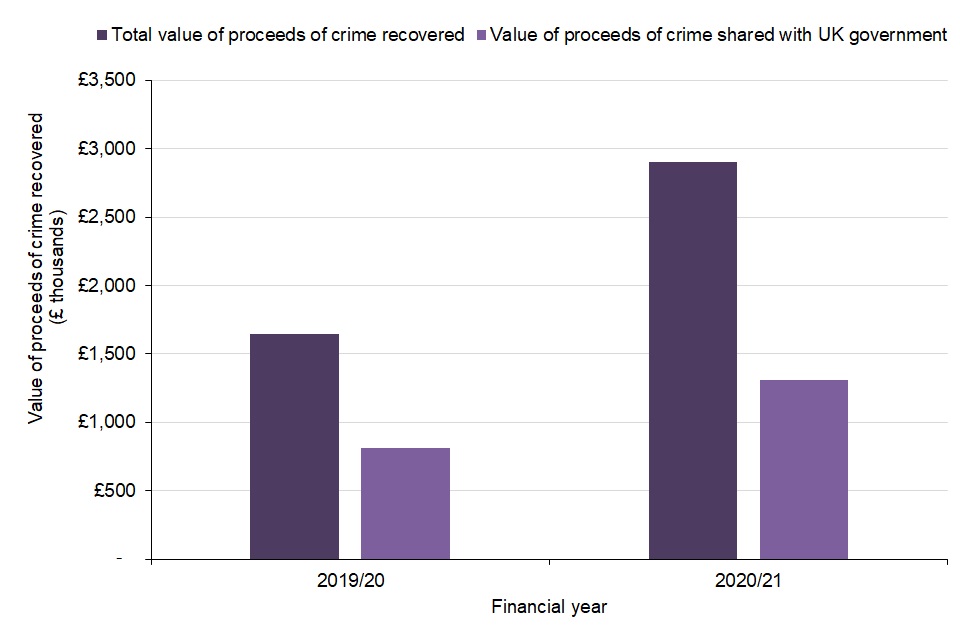
Source: Home Office
Notes
- Data presented in Figure 15 above shows the value of proceeds of crime recovered as a result of International Cooperation in the financial year 2019 to 2020 and the financial year 2020 to 2021.
Figures presented for “Total value of proceeds of crime recovered” show the full value of proceeds of crime recovered as a result of International Cooperation. The “Value of proceeds of crime shared with UK government” represents the value of proceeds of crime recovered which are retained by the UK government.
The total value of proceeds of crime recovered through International Cooperation has increased from £1.6m in the financial year 2019 to 2020 to £2.9m in the financial year 2020 to 2021. The value of money retained by the UK Government has also increased (from £0.8m to £1.3m), although the percentage of proceeds of crime retained has reduced (from 49% to 45%).
The value of proceeds of crime distributed to the UK government are agreed on a case-by-case approach. The UK Government usually retains 50% of money recovered when cooperating with another country, however if there are victims in one country, the money will first be put towards paying compensation to those victims.
Operational agencies in England and Wales and Northern Ireland cooperated with the following countries over the relevant two-year time period: Belgium, Cayman Islands, Czechia, Finland, France, Germany, Guernsey, Italy, Jamaica, Netherlands, Romania, Spain and the United States of America.
Asset Return Cases
The UK, as a signatory to the UN Convention Against Corruption is obligated to return funds where the conditions for mandatory return are met; however, the UK also exercises its discretion to return funds in appropriate cases when it is not otherwise mandated (in line with Article 57(3)(c) of the Convention). This section sets out, for the financial year 2020 to 2021, the value of (a) assets restrained, seized, or frozen which, if recovered, will be returned, (b) assets due to be returned and (c) assets returned. These cases are referred to as “asset return” cases.
| Financial year | Total value of proceeds of crime restrained, seized or frozen | Total value of proceeds of crime recovered but not returned | Total value of proceeds of crime returned to foreign government |
|---|---|---|---|
| 2020 to 2021 | £257,100,000 | £1,720,116 | £4,214,018 |
Source: Home Office
A notable asset return case was the £4,214,018 returned to Nigeria following the recovery of those proceeds of crime from associates of James Ibori. These proceeds of crime were recovered by the Metropolitan Police Service, National Crime Agency, and Crown Prosecution Service. The offences committed by the associates include money laundering, forgery and obtaining property by deception.
This return case was processed under the Article 57(3)(c) of the UN Convention Against Corruption. Conditions of this case were underpinned by the Memorandum of Understanding signed by the UK and the Federal Republic of Nigeria in 2016. Details on the return of the proceeds of crime for this case, including how the funds will be spent, are set out in an Annex to that Memorandum of Understanding.
For asset return cases where the proceeds of crime have been agreed to be returned in principle but are yet to be transferred, see the following cases:
- £456,068 will be returned to Moldova following the recovery of proceeds of crime by the National Crime Agency in the financial year 2020 to 2021, however the process to return the funds, including the agreement of a memorandum of understanding between the UK and Moldovan Governments, is still underway
- £65,622 will be returned to Kuwait following the recovery of proceeds of crime by the Metropolitan Police Service in the financial year 2020 to 2021, however the process for returning these funds did not commence before the end of the financial year
- Serious Fraud Office have recovered a further £1,198,425 in the financial year 2020 to 2021 which still need to be returned however the process for returning these funds did not commence before the end of the financial year due to issues determining where funds should be returned
Users should note figures presented for proceeds of crime restrained, seized and frozen relate to ongoing investigations which means no further information can be shared. These cases have been identified at an early stage in the process which means if they were to be successful any recovered proceeds of crime would be returned abroad. It should be noted there are further cases which are ongoing but are not recorded as ‘Asset Return’ cases.
About these Statistics
Future releases of this statistical publication are pre-announced on the statistics release calendar on the GOV.UK website.
The accompanying Methodology and Quality Report provides information on the different data sources used and the processes for this statistical release, as well as other statistical information about the bulletin.
Feedback
Home Office is keen to receive feedback on its statistical publications to maintain their relevance for users. Any feedback should be directed to the Asset Recovery Performance team through email: POCAPerformance@homeoffice.gov.uk
Press enquiries for this release should be directed to pressoffice@homeoffice.gov.uk or alternatively by telephone at 020 7035 3535.
Other enquiries on these statistics should be directed by email to: CriminalFinancesandAssetRecoveryUnit@homeoffice.gov.uk
Lead Statistician: Molly Lamb
